
Performance: Houghton's Clayton Sayen
May 14, 2018
 Clayton Sayen
Clayton Sayen
Houghton senior – Track & Field
Sayen added another night of highlights to an incredible senior campaign, winning a rare race combination of the 100, 400 and 3,200 meters at the Ontonagon Invitational on May 4 to earn the Michigan Army National Guard “Performance of the Week” for April 30-May 6. He ran the 100 meters in 11.14 seconds to set a school record and the 400 in 49.76 to break another record he already held; Sayen also owns school records in the 200 (22.63) and 800 (1:56.83) and as part of the 1,600 and 3,200 relays.
Also a standout runner in the fall, Sayen capped his final high school cross country season by leading his team to the Upper Peninsula Division 1 championship and claiming the individual title by a tenth of a second with a time of 16:25.7 – the fourth fastest in U.P. Division 1 Finals history. During the winter, he moved on to hockey and helped the Gremlins to a No. 3 ranking in Division 3 during the regular season. He entered this spring as a three-time U.P. Track & Field Finals individual champion coming off last year’s wins in the 200 and 400 and as part of the 3,200 relay. He’s broken his two goals for this season – to go under 50 seconds in the 400 and 1:57.5 in the 800 – and the fastest meets are coming up with his Regional on Thursday at Negaunee and the Finals on June 2. This season also has provided a chance for Sayen to run with his brother Tyler, a freshman on the team.
 Clayton carries a 3.9 grade-point average and will be sticking close to home after this spring, studying and running track and cross country at Michigan Tech. He plans to pursue a degree in engineering management, diving into his interests in science and also business, as he’d like to follow some of the footsteps of his father, a local business owner. But for a few more weeks of high school, Sayen will continue setting the pace – with his trademark headband and sunglasses he’s become known for around the U.P., and also with the speed that should put him in line to contend for a few more championships.
Clayton carries a 3.9 grade-point average and will be sticking close to home after this spring, studying and running track and cross country at Michigan Tech. He plans to pursue a degree in engineering management, diving into his interests in science and also business, as he’d like to follow some of the footsteps of his father, a local business owner. But for a few more weeks of high school, Sayen will continue setting the pace – with his trademark headband and sunglasses he’s become known for around the U.P., and also with the speed that should put him in line to contend for a few more championships.
Coach Daniel Junttila said: “I’ve been coaching 38 years and I’m an outgoing guy, and you meet hundreds of coaches and you talk – and I’ve never spoken to anyone, let alone seen it where somebody will run the 3,200 that well, be a Division 1 champion (and then the 100) … that range of athleticism blows me away. And he just keeps bringing it. … I coached him in eighth grade football, so I knew him really well. He’s a special athlete with such will and drive. I could tell honestly when I saw him in eighth grade, and then I watched him in middle school track, and already as a freshman he was doing things that were very uncommon.”
Performance Point: “My primary focus for the day was the 100,” Sayen said of the Ontonagon meet. “I wanted to break our school record in the 100, which was an 11.23. I ended up getting it with an 11.14, and that was my first real event of the day; I ran the (3,200) relay at the beginning, but that was kinda just a cruise. There wasn’t a whole lot of competition there, so I used that as my warm-up. The 100 was to get the day going … and I won, and I was like, ‘Cool, I got the school record. That’s what I was going for today. So mission accomplished.’ It was a nice day overall, and I decided my next event the 400, I was going to push that one too because it was my goal sometime this season to go sub-50. At 49.76 I ran sub-50 and I met that goal, so the day was just excellent as it was. (Then) I’ve got the 2-mile left, so I’m going to see what I have left. I went out and I pushed myself in that one – not a phenomenal time, but I ended up winning. And it was just cool to have a meet under my belt where I won the shortest and the longest events.”
Run ’em all: When I first started in middle school, I was a distance runner. But growing up, I’ve always been a pretty fast sprinter. Way back in elementary school I was always the fastest kid in my class. It wasn’t until this year where I started doing them both, distance and sprints. My freshman year of high school, I was a strict 2-mile, 1-mile guy. And now I’m more of a 200, 400, 800 kind of guy. So I’ve kinda worked my way around the whole spectrum a little bit. This year I’m going to just try to combine the two and have a little fun with it. Because that was my main goal for the season, to have as much fun as I can.”
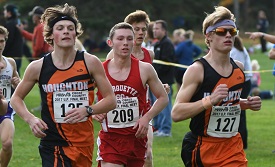 What a finish: “Cross Country was unbelievable – U.P. champions, I was the Division 1 individual winner. Cross country was so much fun, everything about it. I had a lot of fun in hockey too. We had a pretty successful season, had a lot of highlights there. And to wrap it up with track, how this season is going … senior year, athletically, it would be hard to beat.”
What a finish: “Cross Country was unbelievable – U.P. champions, I was the Division 1 individual winner. Cross country was so much fun, everything about it. I had a lot of fun in hockey too. We had a pretty successful season, had a lot of highlights there. And to wrap it up with track, how this season is going … senior year, athletically, it would be hard to beat.”
Brotherly bond: Having (Tyler) on the team with me, it’s a lot of fun. He’s a 400/800 runner, just like me, so before he runs I give him my strategy. He’ll go out and do the best he can – he’s a freshman, so he’s not going to put down some crazy times. … Having him on the team with me, it’s good bonding between the two of us.”
Signature style: “The headband, it started back about eighth grade with my buddy Seth (Helman) one day in practice. In middle school, my hair was kinda long, kinda in my eyes, so I told him, ‘I’m going to wear a headband.’ It just carried through high school, and then I decided to grow my hair really long. It’s not anymore; it’s short now. (But) as the years have gone on, the two of us, the headband has become our thing. That’s what we’re known for – head bands and sunglasses – that’s a thing we do together.”
- Geoff Kimmerly, Second Half editor
Every week during the 2017-18 school year, Second Half and the Michigan Army National Guard will recognize a “Performance of the Week" from among the MHSAA's 750 member high schools.
The Michigan Army National Guard provides trained and ready forces in support of the National Military Strategy, and responds as needed to state, local, and regional emergencies to ensure peace, order, and public safety. The Guard adds value to our communities through continuous interaction. National Guard soldiers are part of the local community. Guardsmen typically train one weekend per month and two weeks in the summer. This training maintains readiness when needed, be it either to defend our nation's freedom or protect lives and property of Michigan citizens during a local natural disaster.
Previous 2017-18 honorees:
May 3: Autumn Roberts, Traverse City Central tennis - Read
April 26: Thomas Robinson, Wyoming Lee track & field - Read
March 29: Carlos Johnson, Benton Harbor basketball - Read
March 22: Shine Strickland-Gills, Saginaw Heritage basketball - Read
March 15: Skyler Cook-Weeks, Holland Christian swimming - Read
March 8: Dakota Greer, Howard City Tri-County wrestling - Read
March 1: Camree' Clegg, Wayne Memorial basketball - Read
February 23: Aliah Robertson, Sault Ste. Marie swimming - Read
February 16: Austin O'Hearon, Eaton Rapids wrestling - Read
February 9: Sophia Wiard, Muskegon Oakridge basketball - Read
February 2: Brenden Tulpa, Hartland hockey - Read
January 25: Brandon Whitman, Dundee wrestling - Read
January 18: Derek Maas, Holland West Ottawa swimming - Read
January 11: Lexi Niepoth, Bellaire basketball - Read
November 30: La'Darius Jefferson, Muskegon football - Read
November 23: Ashley Turak, Farmington Hills Harrison swimming - Read
November 16: Bryce Veasley, West Bloomfield football - Read
November 9: Jose Penaloza, Holland soccer - Read
November 2: Karenna Duffey, Macomb L'Anse Creuse North cross country - Read
October 26: Anika Dy, Traverse City West golf - Read
October 19: Andrew Zhang, Bloomfield Hills tennis - Read
October 12: Nolan Fugate, Grand Rapids Catholic Central football - Read
October 5: Marissa Ackerman, Munising tennis - Read
September 28: Minh Le, Portage Central soccer - Read
September 21: Olivia Theis, Lansing Catholic cross country - Read
September 14: Maddy Chinn, Pontiac Notre Dame Prep volleyball - Read
PHOTOS: (Top) Houghton’s Clayton Sayen carries the baton down the stretch during a relay this season. (Middle) Sayen, right, and teammate Seth Helman lead the pack during the U.P. Division 1 Cross Country Final last fall. (Top photo courtesy of the Houghton track & field program; middle photo by Kara Camps.)
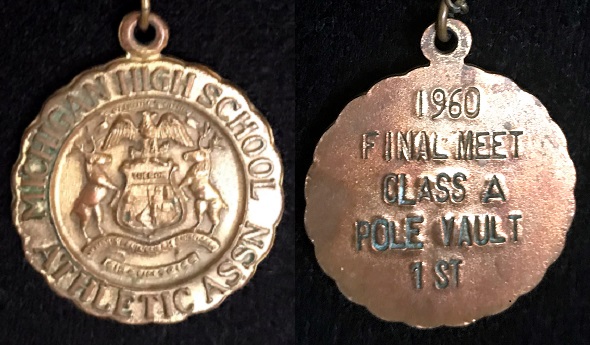
60 Years Later, Co-Champ Rediscovered
March 25, 2020
By Ron Pesch
Special for Second Half
Nicholas “Mickey” Turcheck tells a wild story. It involves a coin flip.
Involved in track & field for much of his life, Turcheck was a pole vaulter at Taylor Center during his high school days, then at Western Michigan University. He later served Taylor Center for more than three decades as track coach, where he mentored five state champions.
He also coached two future Olympians. Earl Jones, who won MHSAA Finals track titles in both 1980 and 1981, and grabbed bronze in the 800 meters at the 1984 Summer Olympics in Los Angeles. Another of his athletes, Deby LaPlante, qualified for the 1976 Summer Olympics in Montreal as a high hurdler.
In Turcheck’s possession is a medal. Etched on the back, pounded out in the style of the time, are five lines.
1960
FINAL MEET
CLASS A
POLE VAULT
1ST
Those 31 characters honor his MHSAA championship performance on what became a windy day in Ann Arbor at University of Michigan’s old Ferry Field.
But there is one problem. Turcheck’s name doesn’t appear on the MHSAA list of Finals champions. According to the list, the championship belongs to Joe Baldy of Monroe.
(The list has since been corrected and amended, per the story to be told below.)
Trackheads
For ‘trackheads’ – diehard fans of the sport and the events that comprise a track meet – as well as sports historians, a newspaper’s agate page is nirvana. Contained within the tiny type are the details that aren’t always relayed within the article covering a sporting event. Things like baseball batting averages, league standings, box scores, stat lines, team transactions, TV and radio schedules, and most everything else that doesn’t fix conveniently into the day’s sports section might appear on the page. For a track meet, a full agate listing will include place finishes as well as times, heights and distances that were used to determine winners of events, as well as detail on record performances that were equaled or topped.
Jim Moyes is a passionate sports fan. An undersized high school athlete at a small school, where participants of all shapes and sizes are valued, Moyes was the son of a prep coach at North Muskegon High School. He grew up and became, among other things, a beloved and respected broadcaster and public address announcer. Few were as well-prepared as Moyes, who studied agate pages, past performances, and, it seemed, the family trees of the participants prior to sitting before a microphone. His knowledge, as well as his sense of humor, was on display for 43 years in West Michigan, where he would balance his understanding and importance of an event with the awareness that, in the end, what we were experiencing was still just a game.
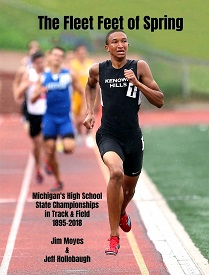 Well over 30 years ago he began his research into a passion project. Moyes is a ‘trackhead.’ And, because of this, in 2019, he officially became the author of a published book.
Well over 30 years ago he began his research into a passion project. Moyes is a ‘trackhead.’ And, because of this, in 2019, he officially became the author of a published book.
Way back, Moyes began digging into microfilm with the goal of capturing the names and events behind each MHSAA Finals track championship. He shared his initial research with the MHSAA, and for years the Association has highlighted his work on its website with lists of individual state champions on both their boys and girls track pages.
A couple of years before wrapping up his research, Moyes began work with another certified ‘trackhead,’ Jeff Hollobaugh – associated editor of Track & Field News, the voice of countless track meets, and as Moyes states, an “expert on this great sport” – to tell the stories of the meets in book form. “The Fleet Feet of Spring” – a history of Michigan’s High School State Championships covering the span 1895-2018 – was the result.
That’s 24,446 state champions. Simply put, its 439 pages contain a marvelous collection of statistics, stories and images.
But, with good reason, Turcheck’s name doesn’t appear in the publication.
Golden Age of Newspapers
Post-event press coverage on the 1960 MHSAA State Track Meet for most readers across Michigan arrived in their newspaper courtesy of coverage by wire-service reporters from The Associated Press or United Press International. With four meets to cover that encompass hundreds of prep athletes, the arch of the stories generally focus on record-setting events and streaks of success.
In Class A, the story was focused on the Pontiac Central squad that slipped past Flint Northern, 44-41, for its fifth title in six years. It was the seventh year in a row that the Vikings finished second at the meet. Pontiac junior Bredell Pritchett’s 59-foot-5¾ toss of the shot exceeded the previous state mark by better than two feet. Northern’s Maurice Pea, clocked at 9.8 seconds, tied a 35-year-old mark in the 100-yard dash. Al Ammerman of Dearborn established a new high jump record.
In 1960, the details of the pole vault simply weren’t the story.
Available space in newspapers is dictated by advertising. That certainly is the case today, and was most certainly the case back in the glory days of newsprint. Decisions are made by sports editors and staff on the amount of space available, and what agate will be printed. The results of a track meet, let alone the four simultaneous meets that comprise the MHSAA state championships, can certainly eat up plenty of real estate.
Relatively few papers around Michigan dedicated space to the MHSAA Track Championships back in May 1960. The old Detroit Times is among those that did include agate. Study of the listing however provides little clarity, as the paper listed only Metro Detroit finishers beyond the event winners. For the pole vault, that means confusion.
Pole Vault – “1 Joe Baldy, Monroe: Mickey Turcheck. Taylor Center: Bob Davis. Redford Union. and Larry Richardson. Livonia Bentley. were among those tieing for fourth. Distance 12 feet, 9 inches.”
The Grand Rapids Press agate adds haze to the mix. Baldy is listed in first, but Turcheck is listed as finishing second, followed by Flint Northern’s Jerry Wright in third. Davis, Richardson, Mike Pedler of Muskegon, J. Best from Battle Creek Central and Bill King of Traverse City are listed as occupying fourth place
The Battle Creek Enquirer lists only Baldy as the winner of the event and John Best “tied for fourth.” The Lansing State Journal agate shows only Baldy as the event winner. No track agate appears in the Detroit Free Press. Although the paper notes that team-wise, Birmingham finished third with 18 points, followed by Dearborn, Ann Arbor, Muskegon and Saginaw Arthur Hill in its coverage, the results from the Class A pole vault are not mentioned.
The Traverse City Record-Eagle does not include agate, but the article notes King’s fourth place finish, and that the Trojans track team spent the night sleeping on tumbling mats in the Saginaw Arthur Hill gymnasium when its bus broke down on the return trip home from Ann Arbor.
So, with little surprise, Moyes’ research concluded Baldy was the 1960 Class A pole vault champion.
Story of the Medal
In early March, Tony Mifsud, a longtime track coach at Dearborn Divine Child, contacted MHSAA Director of Broadcast Properties John Johnson about the story.
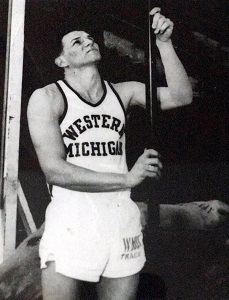
Turcheck was recently visiting a friend, Bob Parks, the head track coach at Eastern Michigan University for 34 years and an assistant track coach at Western Michigan during Turcheck’s time in Kalamazoo competing for the Broncos. On a visit this past fall, Parks mentioned the Moyes and Hollobaugh book that he had recently received.
“Mick, your name is not listed there,” said Parks. “I know you were tied for the state championship because I was the coach at Redford Thurston at that time and I was at the state meet. I remember you being announced as the co-state champion of the pole vault.”
“I said, ‘Really?’” recalled Turcheck from his home in Taylor.
After the visit, he made a couple of phone calls to friends. In turn, some of those folks began reaching out to others with the story.
According to Turcheck, after the pole vault was over, a meet official said they only had one medal and they were going to flip to determine who would receive it. Turcheck won the coin flip and was awarded the souvenir. A duplicate medal was to be mailed to his co-champion.
Newsprint and the Miracle of Microfilm
Before the days of smartphones, e-mail, websites, pop-up ads, and cloud storage, the history of cities, big and small, was captured in print and sold on street corners, at newsstands, and, beginning in 1947, by coin-operated vending machines.
Monthly subscriptions meant home delivery of the day’s news, and newspapers were everywhere.
Before Craigslist and Google Ads, there was money to be made in helping businesses advertise their wares, employers to advertise job openings, and for individuals to sell items and offer apartments for rent in the classifieds. That strong revenue stream supported large staffs and solid coverage of local events at daily and weekly newspapers.
Some of that content – that history – is slowly coming online, but most of it remains tucked away on microfilm and microfiche in local libraries across America.
And sometimes, local pride resulted in details about the exploits and accomplishments of area athletes to appear in smaller town publications that cannot be found elsewhere.
Niles Kruger, a sportswriter at the Monroe Evening News, followed up on a request by Johnson to check microfilm from newspapers in the area for any detail that might exist. Fortunately, the coverage in the Evening News appears to help clear up much of the story.
The article also illustrates an issue often injected upon microfilm by small agate-style typeface. Characters can often bleed or blur and appear to be other letters. A lower case ‘s’ can look like an ‘a’ or an ‘e’; a lower case ‘i’ can look like lower case ‘l.’ Unexpectedly, this, too, was illustrated here.
And sometimes, long lists are subject to other errors.
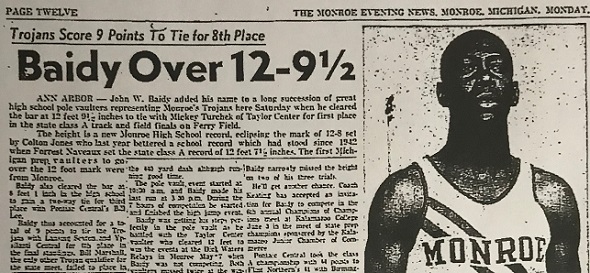
‘Baidy’ not ‘Baldy, ‘John’, not ‘Joe’
“ANN ARBOR - John W. Baidy added his name to a long succession of great high school pole vaulters representing Monroe’s Trojans here Saturday,” stated the Evening News, “when he cleared the bar at 12 feet 9 ½ inches to tie with Mickey Turcheck of Taylor Center for first place in the state Class A track and field finals on Ferry Field …”
“Baidy also cleared the bar at 6 feet 1 inch in the high (jump) to gain a two-way tie for third place with Pontiac Central’s Bill Lee. Baidy thus accounted for a total of 9 points to tie the Trojans with Lansing Sexton and Ypsilanti Central for 8th place in the final standings.”
While there is no mention of the flip for the metal, the article backs up Turcheck’s recall of the day.
Recognizing that despite their best efforts, Moyes and Hollobaugh know that errors can appear in the publication. In their “Notes to the reader” section, they ask readers to please make contact if any mistakes are spotted.
“Thanks to today's modern technology Jeff Hollobaugh will be able to make the appropriate corrections in our book” noted Moyes from Florida via email, noting the marvels of the times we live in. “Better yet for Jeff & I,” added Moyes, displaying his comedic style, “with the amended corrections maybe Mickey Turcheck will purchase our newly revised book.”
Search for Baidy
“They wanted to flip a coin,” said Baidy recently, surprised in the sudden interest in a day from so many years ago and chuckling at the memory. “He got the call and got the medal. I really don’t remember if they told me if I was supposed to get a medal (in the mail). Right after that I had to go to the high jump or something.”
Baidy – who also tied for the Class A Finals high jump championship in 1959 – had received a call earlier on this day from his long-ago opponent from Taylor Center.
“I would certainly like to meet him again,” said Turcheck. His former high school sweetheart and bride had used her smartphone to seek out Baidy’s contact information, and soon after, the two old athletes were reminiscing about the day. Turcheck pitched the idea of getting together for lunch or dinner sometime soon.
“That’s what he wants to do, and it’s all right with me,” Baidy said, noting plans after things settle down. “We’re lucky to still be alive.”
 Ron Pesch has taken an active role in researching the history of MHSAA events since 1985 and began writing for MHSAA Finals programs in 1986, adding additional features and "flashbacks" in 1992. He inherited the title of MHSAA historian from the late Dick Kishpaugh following the 1993-94 school year, and resides in Muskegon. Contact him at [email protected]:void(0);t with ideas for historical articles.
Ron Pesch has taken an active role in researching the history of MHSAA events since 1985 and began writing for MHSAA Finals programs in 1986, adding additional features and "flashbacks" in 1992. He inherited the title of MHSAA historian from the late Dick Kishpaugh following the 1993-94 school year, and resides in Muskegon. Contact him at [email protected]:void(0);t with ideas for historical articles.
PHOTOS: (Top) The 1960 Finals championship medal, front and back, awarded to Baidy. (2) The Fleet Feet of Spring has been revised based on the latest re-discovery of a co-championship. (3) Mickey Turchek went on to compete at Western Michigan. (4) The Monroe Evening News announced John Baidy’s championship pole vault as part of its coverage of the 1960 Class A Track & Field Finals. (Turchek photo courtesy of the Turcheck famly; newspaper clipping courtesy of the Monroe Evening News.)

